

When the root is the lowest note, the chord is in root position.Ĭhords can also be inverted (turned upside down). In all the chords we've looked at so far, the lowest note in the chord was the root. In a minor key, i and iv are minor, ii is diminished, and V is major and includes an accidental (because of the raised 7th of the scale). In a major key, I, IV and V are major chords but ii is a minor chord. No! In Grade 5 Theory, you only have to recognise chords I, II, IV and V. Here are the C major chords with their Roman numeral names:ĭo I have to learn all these chords for Grade 5 Theory? You can write them all with capitals in your grade 5 theory exam.) (Major chords are sometimes written with capital Roman numerals, whereas minor chords are written with small letters. We also use Roman numerals to name chords. Minor chords are made with a minor third and a perfect fifth above the root.ĭiminished chords contain a minor third and a diminished fifth above the root.Īugmented chords contain a major third and an augmented fifth. You don't need to use any augmented chords in the Grade 5 Theory exam though! Major chords are made with a major third and a perfect fifth above the root. Here are the chords in A minor with their names: This means you always have to raise the 7th degree of the scale by a semitone (half step).

In a minor key, the chords are built from the notes of the harmonic minor scale. Your browser does not support the audio element. Here are the chords in C major with their names: Triads/Chords can be major, minor, diminished or augmented. Notice that the notes of these triads are either all on lines, or all in spaces. A triad is always made up of a root, a third above the root, and a fifth above the root. (See “ Lesson 7: Intervals” for more about intervals). The notes we add are the third and the fifth. To make a chord, we choose one of the notes of the scale and add another two notes above it. Let’s take the key of C major as an example: To make chords, we first need to decide which key we are in. Once you understand this lesson for a cheat sheet click here Chord Formula's and get the bottom 2 images.Grade Five Music Theory - Lesson 10: Describing ChordsĪ chord is a group of notes which sound at the same time.Ĭhords are usually made up of three basic notes, (but any of the notes can be doubled up without changing the nature of the chord). You will notice below there are some notes like Cb(B) if you look at the musical scale there is no sharp or flat between B and C or E and F, therefore Cb is a B. Yet say we want to make a minor chord, we would simply flatten the third note so major is C E G and E is the 3rd note of the scale so we change it to an Eb (E flat) it is that simple. We then attach numbers to the scale so C is 1, D is 2, E is 3, F is 4, G is 5, A is 6 and B is 7, as the scale has seven notes, then we take the root (C as we are making a C major chord - D if you wanted to make a D major chord) then count to 3 which is E then count to 5 which is G so the notes for the chord are C E G. So to make any chord we take the scale of the chord so for a C major chord we take the C major scale which is C D E F G A B.


Please note the following notes / chords are the same G# = Ab and A# = Bb and C# = Db and D# = Eb and F# = Gb. How do we know what notes make up which chords ? All the notes that make up the major, minor, 7th, 6th, augmented, dominant 7th, diminished, diminished 7th Chord for beginners.


 0 kommentar(er)
0 kommentar(er)
